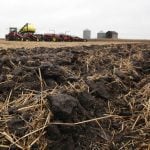
Tag Archives Fertility

Sorting out the noise on fertilizer biologicals and biostimulants
With more companies entering the biologicals and biostimulant space, Prairie farmers are being urged to look past the hype and dig into the data

Split nitrogen pays off on protein, not yield
High-yielding wheat varieties need a lot of nitrogen, but new research suggests that splitting that application may decrease the economic and ecological risk while also paying dividends on protein

Beef 911: Rectal palpation versus ultrasound for pregnant cows
Both methods have advantages, but the key is having reproductive exams at least once a year

Farmer panel discusses 4R nutrient stewardship
There could a fifth ‘R’ in sustainable nutrient management — the right economics
Beef 911: On-farm semen collection is a valuable tool
With a valuable bull, on-farm collection becomes like an insurance plan preserving his genetics for the future

Reading soil tests key for proper nutrient use
The devil is in the details when it comes to nutrient application, meaning there is no silver bullet, just lots of hard work

White spots speak volumes about alfalfa’s needs
Alfalfa can pull down its own nitrogen from the atmosphere, but can’t conjure up phosphorus, potassium, sulphur, and boron out of thin air
Alfalfa isn’t a plant that complains a lot, but white spots on its leaves are a clear plea for more potash. After poking around in the field surrounded by whispering poplars at the recent Hay Day tour near Neepawa, provincial soil fertility specialist John Heard pointed out a shining example of “full-blown potassium deficiency.” FarmersGot bald patches on eroded knolls? Ammonium sulphate may be the cause
New study says Brazil beats Iowa in protecting waterways from eutrophication
Brown University study finds deficient Brazilian soils hold on to phosphorus while rich Iowan farmland is spoiling waterways even though much less of the fertilizer is being applied
A new American study has turned a long-held belief on its head by discovering that — in one respect, anyways — growing soybeans in Iowa is environmentally worse than growing them in the former Amazon rainforest. Researchers from Brown University found Iowa farmers are doing more harm to waterways than their counterparts in Matto Grosso,

